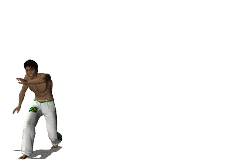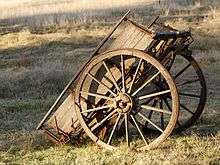Cartwheel (gymnastics)
A cartwheel is a sideways rotary movement of the body. It is performed by bringing the hands to the floor one at a time while the body inverts. The legs travel over the body trunk while one or both hands are on the floor, and then the feet return to the floor one at a time, ending with the athlete standing upright. It is performed in a variety of athletic activities, including performance dance and some types of Indian dance, in gymnastics and cheer, and in the martial arts of capoeira. It is called a cartwheel because the performer's arms and legs move in a fashion similar to the spokes of a turning (cart) wheel. In classical Indian Karana dance, it is called talavilasitam, and in capoeira is called aú.


Technique
To perform a cartwheel, one moves sideways in a straight line, keeping the back straight, butt and core tight and head in; places the hand of the same side on the ground, followed by the other hand; kicks the legs over the body and brings them down as the hands and body come up to a standing position.
A classic cartwheel performed with proper gymnastics form always starts with a forward lunge: the lead leg (stronger leg) in front and the weaker leg in the back. During the lunge, the gymnast has her arms high in the air and straight, with hips square and belly button, facing forward. The gymnast then pushes off the front leg and places her hands side by side on the ground in front of her. As she does this, she kicks her legs up and over her torso and head as her body becomes inverted. During the rotation, the legs stay apart in a large, wide straddle (as far apart as the gymnast can get them). The legs are straight, and the toes and feet are pointed. In United States competitions, the legs must reach at least 90 degrees of motion in a competition in order for the gymnast to receive a lot of points. Finally, the gymnast sets her first foot on the ground, followed by the second foot, landing in a lunge with the weaker leg in front and the lead leg in back. The gymnast lands facing the opposite direction from the one she started in, hands and arms straight and high, then salutes.
Bent-leg cartwheel
A bent-leg cartwheel describes a cartwheel where the legs are bent rather than outstretched when the body is inverted. It can be useful interim training technique for gymnastic pupils attempting to learn the full cartwheel as the smaller body area is easier to control.[1]
In gymnastics
_236.jpg)
Cartwheels are commonly performed in gymnastics in the floor exercise and on the balance beam. On the floor, a gymnast may precede a cartwheel with other movements, as in a chasse cartwheel, which begins with side-step "gallops". It is a required skill in the USA Gymnastics Level 4 compulsory beam routine.
See also
- Aerial cartwheel, a hands-free cartwheel
References
- Broomfield, Lindsay (2 March 2011). The Complete Guide to Primary Gymnastics. Human Kinetics(ADVANTAGE). p. 92. ISBN 9780736086585.